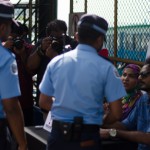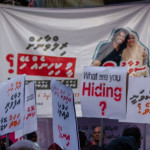Sunday will mark 100 days since Minivan News journalist Ahmed Rilwan disappeared. As friends and family continue to hope for his safe return, some of Rilwan’s best work will be re-published as a reminder of his talents and dedication to his profession.
This article was originally published on April 23, 2014, following the arrest of 79 young people during the Anbaraa music festival in Baa Atoll.
Last weekend’s raid of the Anbaraa island music festival was defended by police as being part of law enforcement efforts to “safeguard youth and the society from dangers of drugs”.
But how successful are the current methods in keeping the youth away from drugs?
Beginning with soft drugs in the seventies, and later with the introduction of heroin around 1993, the drugs issue became a national epidemic in the nineties with the number of drug-related offenses increasing rapidly since that time.
The National Drug Use Survey (NDUS) of 2011-2012, conducted by the UNODC, revealed that there were 7,496 drug users aged between 15 and 64 years in the Maldives. According to the survey, 72 percent of the drug using population was under the age of 24, and 48 percent of the drug users in the capital Malé were between 15 and 19 years.
A 2003 Rapid Situation Assessment by the Narcotics Control Board revealed that the age at which young people start using drugs ranged between 10-27 years (a mean age 16.8 years).
Those young people are often arrested and sentenced to long periods in prison, while more and more join them in becoming frequent users and addicts.
It has been suggested that Maldivian prison population could be reduced by up to two-thirds if the government would decriminalise the offence of drug use, and propose mandatory rehabilitation.
Rehabilitating rehab
The NDUS report said the Maldives’ response to the drug problem appeared to be skewed heavily towards the criminal justice system rather than health and social welfare systems.
Considering this, the report proposed turning this around by approaching the issue from three broad angles – supply reduction, demand reduction, and harm reduction.
One key achievement in this change was the Drug Act, introduced in 2011 with provisions for treating drug users instead of opting for incarceration. Under the Act, the National Drug Agency (NDA) has been mandated as the lead agency dealing with all issues related to drug prevention, harm reduction, and treatment.
A Drug Court was also formed under the new act as part of a policy shift away from taking a punitive approach against small-scale drug offenses.
Earlier this month, the NDA reported that 101 offenders have completed their drug rehabilitation programme. But how successful is this programme?
Mohamed Shuaib, the CEO of ‘Journey’ – a support NGO for recovering addicts – said the rehabilitation programme in the Maldives had failed completely.
“Three months later they start using again. While a lot of money is spent on these programmes, right now it is just a small prison. There is no good treatment programme there,” he said.
He highlighted various failures ranging from the programme’s structure and staffing capacity, to unrepaired damages at the buildings and the lack of capacity in the programme itself.
“People in prisons who have been sentenced to rehabilitation are also waiting for such an opportunity. If this stays this way the [expected] result of [establishing] the Drug Court will not be seen,” the judge has said.
Judge Mahaz called on authorities to speed up the process of sending cases to the court, stating that out of 1,616 cases only 19 were submitted within a month of the incident.
Fathimath Afiya, the Chairperson of the Society For Women Against Drugs (SWAD) said the rehabilitation programme currently only existed “just for name’s sake”.
“We visited the [rehabilitation center] place for an assessment just around the time the new government came to power. And it is true, the programme is there just for name’s sake,” she said.
“There is no stable programme. The place is full. There are so many issues. While the Drug Court is sending more and more people, there is no stable programme for them.”
Afiya said the government had started taking action regarding the issue now, and that SWAD was closely following it.
“SWAD is lobbying to work towards a long term strategic solution, based on a strategic action plan and prevention policy. The government is listening to our recommendations and bringing small changes already.”
She said the importance of following a systematic plan is to work realistically towards a solution instead of having every new government introducing something new with each new term.
Long term reform
Journey’s Shuaib also noted the importance of having a long term plan to addressed the issue.
“There have never been any research and evidence based prevention programmes in the Maldives. It is always an ad hoc approach. Our outreach teams have observed that there are a lot of new users now.”
Shuaib said prevention is of the utmost importance and, since children start using drugs, parental guidance and providing children with information will help them make the right choice.
“Even in the US their policy was using guns and force but it did not work. So now they are reforming their drug policy to focus on prevention. Prevention is more important. Young people who were using hash oil three or four years back are now using heroin,” Shuaib said.
Speaking to Minivan News, one recovering heroin addict said the programme ‘s failure could be connected to the Drug Act itself.
“Every one at the programme does not always want to deal with their issue. Many just don’t care about it and are there only because they have been ordered to do so. This makes things harder for those of us who genuinely want to get better,” he said.
While Minivan News was unable to get a comment from NDA regarding the issue, all NGOs expressed hope that the programme can be saved, with the agency currently taking steps towards reform.
Supply, demand, and harm
In terms of supply reduction, drugs confiscated by the Maldives Customs Service while being imported to the Maldives in 2013 include 6.98 kg of heroin and 10.73 kg of hashish oil, while the numbers in 2012 were 4.12 kg of heroin along with 8.39 kg of hashish oil.
This is relatively small amount compared to what is being imported to the country, considering the huge demand. The 24 kg of heroin seized by police last month gives an idea of the true scale of the problem.
Last year police dealt with 38 cases of buying and selling of drugs and 130 cases of trafficking drugs, while there were 2,139 drug use cases and 833 possession cases. Even less is done with regards to major drug dealers.
With regards to large-scale drug dealers, previous attempts by former President Mohamed Nasheed to apprehend some of the nation’s most prominent drug dealers failed to bear fruit. Among them, Adam Naseer was found innocent by the Criminal Court despite police finding over MVR6 million (US$461,500) in cash and drugs just outside his home.
In June 2011, police arrested another ‘top dealer’ Ibrahim ‘Shafa’ Shafaz, finding 896 grams of illegal drugs in his apartment. This February he left the Maldives for ‘medical treatment’ and has appealed his eighteen year jail term to the High Court from abroad.
While NGOs seem hopeful about fixing the rehabilitation program, a complete change in policy and approach to the drug issue is needed to protect the youth from drugs.
These examples only provide further evidence – if it is needed – that a more efficient way must be devised, moving away from the criminal justice system approach, towards a method based more closely on supply, demand, and harm reduction.
Mohamed Rashad – the 24-year-old found dead after a heroin overdose on April 1 – is a testament to this failure, passing away within 24 hours of being released from the Himmafushi drug rehabilitation centre.
 (0)Dislikes
(0)Dislikes (0)
(0)





This is a good question and one of the positive roles of media is to ask good questions.
Hope you do not loose focus on this issue with gossips, aracnut trees and black magic stories… because thats EXACTLY why distractions are created.
@Hero
This is your Beautiful,islamic and intelligent,special Maldives.Worse than terroristan